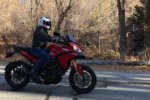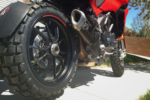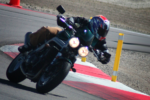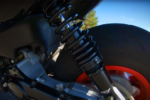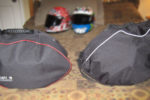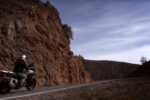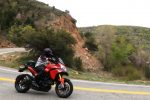Aside from the helmet, the motorcycle jacket is probably the most significant piece of motorcycle gear we search for. Klim, based out of Rigby Idaho, started out making snowmobile kit, but has been moving into the motorcycle market, bringing years of experience battling winter conditions with them and completely raising the bar on what a motorcycle jacket is capable of providing.
The Klim Badlands coat, which isn’t even Klim’s flagship coat, seems to be everywhere these days. A Gore-Tex shell with Superfabric on impact areas, top-shelf D3O armor, fully vented, fully waterproof adventure gear that promises to be true four-season (not just three season, but a for-real, four season) riding coat. But it rings in at, not-an-impulse-buy, $949 to $999.
If you are here, it’s probably safe to assume you’ve already watched the great YouTube videos from RevZilla and Rocky Mountain ATV/MC and the like that detail the myriad of features that have been packed into the Badlands coat. However, if you are anything like us, you want to know if the Badlands coat, and all the tech that has been packed into the it, justifies the $1,000 price tag.
Taking the Badlands to the Badlands
As soon as we got our Badlands coat, we set off for 10-days across Wyoming to visit the Badlands in South Dakota. It seemed as good a reason as any.
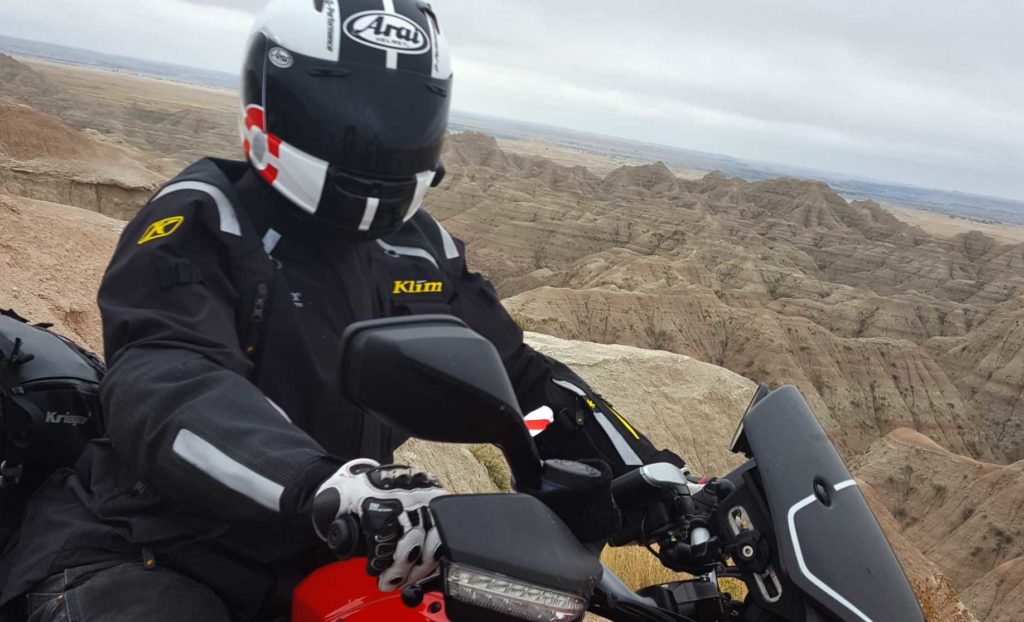
We would also be heading out mid September. Mid-September in the Rocky Mountains can be a volatile time to travel, and it certainly was for us. We saw everything from 100-degree temperatures to torrential rains to frozen roads, snow plows and a foot of fresh snow. In other words, our choice of destination and time of year allowed us to really put the coat through its proverbial paces.
Fit
Klim coats do not come in the plethora of sizes like many European brands. You get to choose from small, medium, large, extra-large, 2x and even 3x. Klim also says that it’s really important to have a fit that is probably a little more roomy than what you may be used too. They say it should be able to accommodate layering when it’s cold and be big enough allow for space between you and the jacket for when it’s hot. More on that in a bit.
To help facilitate finding the best fit, Klim’s website has a Size Advisor that is one of the neatest features we’ve seen on a website in a long time. In the Size Advisor, you put in your basic information; height, weight, and then how you like a jacket to fit; snug or roomy. Answer a few questions specific to your build, then compare the sizes you wear from a database of 3,000 other brands. The Size Advisor gives you a size recommendation ratio. In my case, it recommended a size medium by 83-percent. And sure enough, when the jacket arrived the fit was spot on.
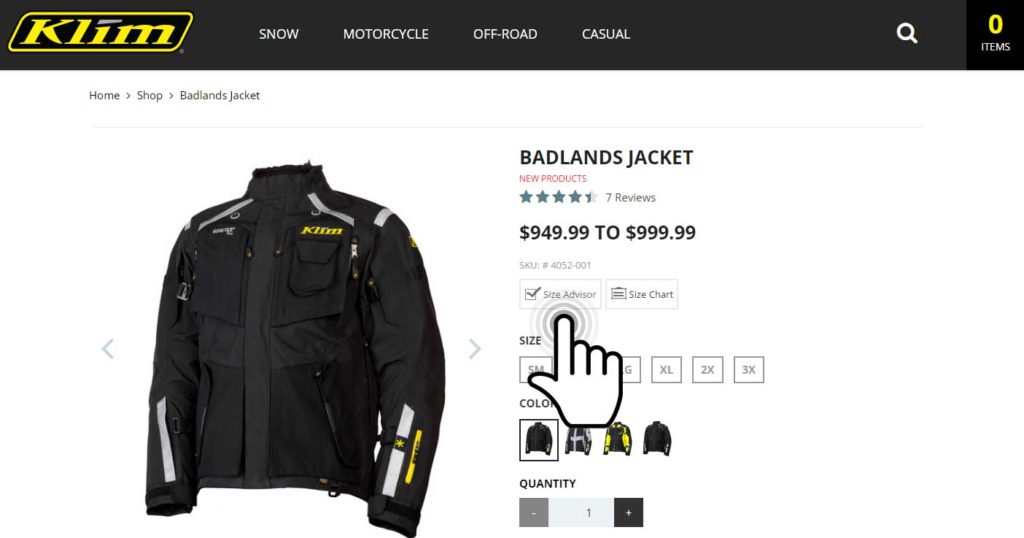
The arms seemed to be a smidgen on the long side when the coat was new. Several online reviews call this out as a problem with the coat, but we would disagree. When you reach forward to the handlebars, the arms don’t seem so very long. Only when standing around the gas station did they feel they could be shorter, but as the jacket wore-in and wrinkles developed around the elbows, the length of the arms become less of an issue.
One feature about the fit that really impressed us was the cut of the shoulders. Many jackets we’ve tested over the years feel fine when you try them on in the store or are walking around, but when you raise your arms, a poorly cut coat will bunch around your neck. Frustrating when you reach up to grab anything, but when you are on the bike this bunching around your neck, moves the shoulder armor away from the shoulders, fouls the helmet and makes it more cumbersome to turn your head. This feature alone has caused us to grow to loathe several otherwise good coats.
Pulling the Badlands coat on for the first time up came the arms and much to our delight the jacket stayed perfectly in place! The articulation of the shoulders is outstanding! Highest possible praise to Klim for getting this right!
Something else we noticed when we pulled the coat out of the giant box it arrived in was the weight. All the D3O armor, Chest Protector, Superfabric and overall build of the jacket make it feel substantial. The weight is actually more similar to what you would expect of a fully armored leather motorcycle coat.
Function
How a jacket performs during the day-to-day riding requirement is the most important part of any jacket, particularly when you are on the road for an extended amount of time and you are wearing that jacket for 10 or more hours per day. In short; absolutely outstanding! We were blown away by how well it worked.
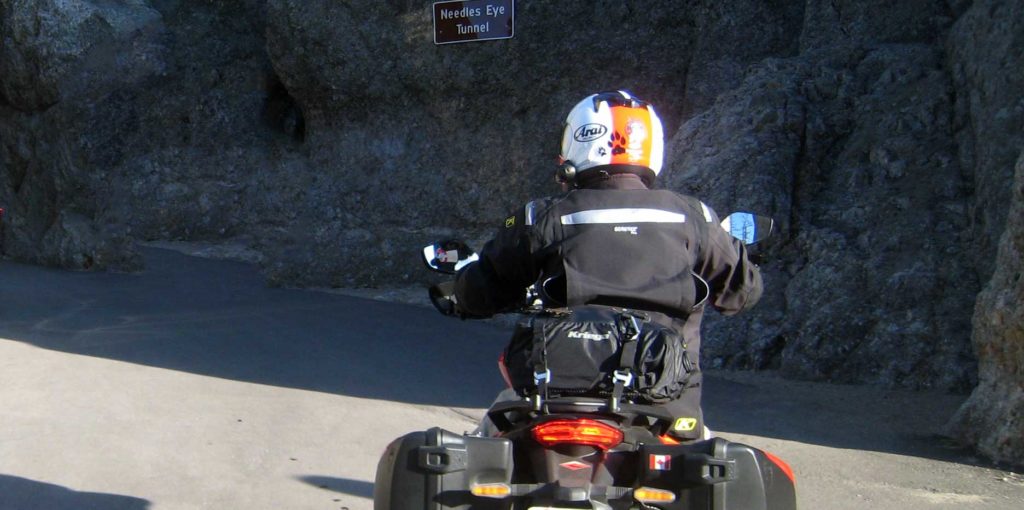
We’ve already mentioned how well the cut of the jacket worked around our shoulders, but every other facet of how the jacket fit appeared to be focused on keeping the jacket in place while riding. The back of the coat is significantly longer than the front. It looks kinda’ odd when you are just standing there, but the shorter cut at the front kept the jacket from bunching up around the chest when sitting on the bike, and the longer “tails” on the back of the coat prevented any kind of drafts from sneaking in. Even the density of the material in different places of the jacket seemed to accommodate how a rider moves on a motorcycle.
The value in how well the jacket fit cannot be understated. It basically meant that while riding the jacket becomes transparent. You simply stop thinking about it, which allows the rider to focus more on the riding, the views and live in the moment more completely.
Earlier, we mentioned that Klim wants the jacket to fit the rider a little less snug than many of us are accustomed too. They say this is for temperature control, and by allowing for space between the riders body and the jacket allows for what they call a “micro climate”. Added to the all the functions that Gore-Tex offers and you really do end up with your own portable environment. Like we said, during our initial test, we saw temperatures that ranged from triple digits to snow storms. With only minor adjustments to our base layer, and by adjusting the vents on the coat, we stayed very comfortable despite what the weather was throwing at us.
Which brings us to vents. The Badlands has vents on the chest, the upper arm, the wrists, and the back. Plus two massive underarm zippers. All the zippers employ a waterproofing called Aquaseal, plus the vents on the arms have a flap that can be closed over the top of the vent or held open to create an air-scoop, funneling in even more air.
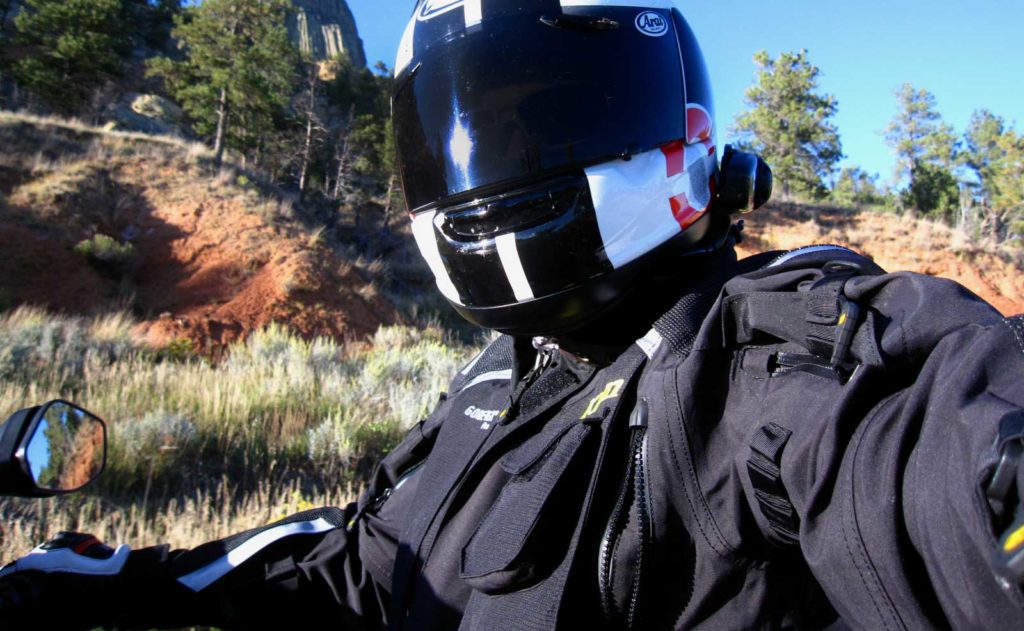
All these vents are incredible and move so much air that we found that even up to 100-degrees we’d leave some of the vents closed, and the vents under the arms move so much air that leaving them all the way open actually flowed too much air, so they never really were opened more than just half way.
If one was doing more rigorous off-road riding, the added venting would be a godsend, but for our more sedentary street riding, the vents were more than adequate for our needs, even in very warm temperatures.
Features We Loved
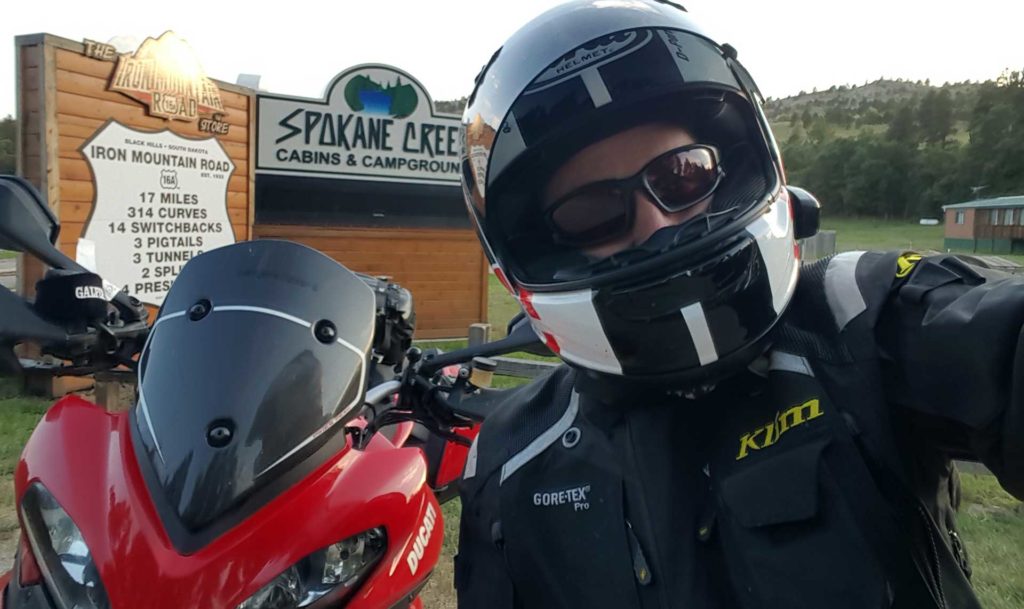
Gore-Tex Pro
Invented in 1969, Gore-Tex is able to repel liquid water while allowing water vapor to pass through, and is designed to be a lightweight, waterproof fabric for all-weather use. Gore-Tex is made by stretched heated rods of polytetrafluoroethylene (PTFE). The discovery of the right conditions for stretching PTFE was a happy accident, born partly of frustration. Instead of slowly stretching the heated material, Bob Gore applied a sudden, accelerating yank. The solid PTFE unexpectedly stretched about 800-percent, forming a microporous structure that was about 70-percent air.
That’s Gore-Tex. Gore-Tex Pro uses a multilayer membrane system with an added microstructure. The membrane is bonded to both the outer material and a specially developed inner layer. The 3-layer Gore-Tex Pro is more durable, but also enhances breathability, reduces weight, has more internal abrasion and snag resistance and is more resistant to UV. It was initially developed to withstand more rugged and windy environments. It is used extensively in mountaineering equipment – like the stuff they wear on Mt. Everest.
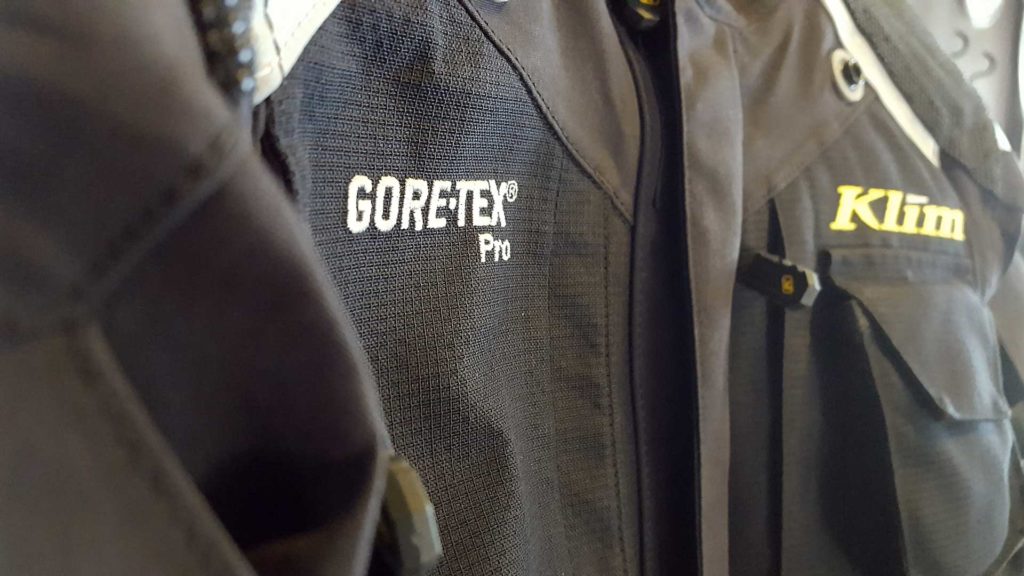
Plus, much to our surprise, Gore-Tex is amazingly easy to care for. Simply wash it on cold, with no fabric softeners, and no spin cycle. Then simply tumble dry it on a gentle, warm cycle to reactivate the water-repellent treatment. Gore-Tex Washing Instructions.
No Liners
Most every other company will sew a jacket together include a waterproof liner and call it waterproof. This is probably the most common configuration out there. Klim is different. The jacket is actually waterproof, because every seam is taped and sealed and every zipper has Aquaseal.
Waterproof liners sound good on the surface, but the real world application of them is less impressive. First, if it starts to rain, it requires a stop. You get off the bike, dig through your luggage to pull out the liner, take off the coat, insert the liner and away you go. So then you ride off into the rain while the shell of the coat gets saturated in water making it wet and all that wet material comes with the thermal dynamic feature of making you even colder. There’s even been a few times where after a long day of riding in the rain, our jackets were so wet that even by morning they were still damp. Nothing like putting on a cold, damp coat before heading out first thing in the morning.
We’ve grown so tired of waterproof liners that most of us simply give up on them and will opt for a traditional rain-jacket. It’s the same level of hassle. You have stop, dig it out of your luggage, put it on, but your actual riding coat doesn’t end up soaking wet.
As we left South Dakota behind us and entered into Wyoming, a massive wall of black welcomed us. Intense winds and sheets of rain doused us for hundreds of miles with no relent. With the Gore-Tex Pro equipped Badlands, no stopping was necessary, we just soldiered on. Even after several hours of a constant barrage of rain, wind and cold, it remained toasty, dry and warm inside the jacket.
Kidney Belt
It may not sound like much, but the Badlands coat has an integrated kidney belt. At first, I suspected this would be one of those things I’d end up removing from the coat but as it turns out it’s one of the features that has endeared me to the jacket so deeply. For a few reasons; first it’s slimming. I mean, it’s important to look good for photos. More importantly, it encourages good posture and it helps the jacket stay put while riding and while moving on the bike.
Oddly, the kidney belt, for me at least, seemed to enhance my level of confidence in the jacket, so much so that if I forgot to fasten the belt before riding away, the absence of the kidney belt was actually distracting. Distracting to the point that I would actually pull over put it on. In fact, I’ve grown to love the integrated kidney belt so much that I’ve had a hard time wearing other jackets ever since, including a favorite, very high-end leather coat that I wear all the time.
G-Hooks
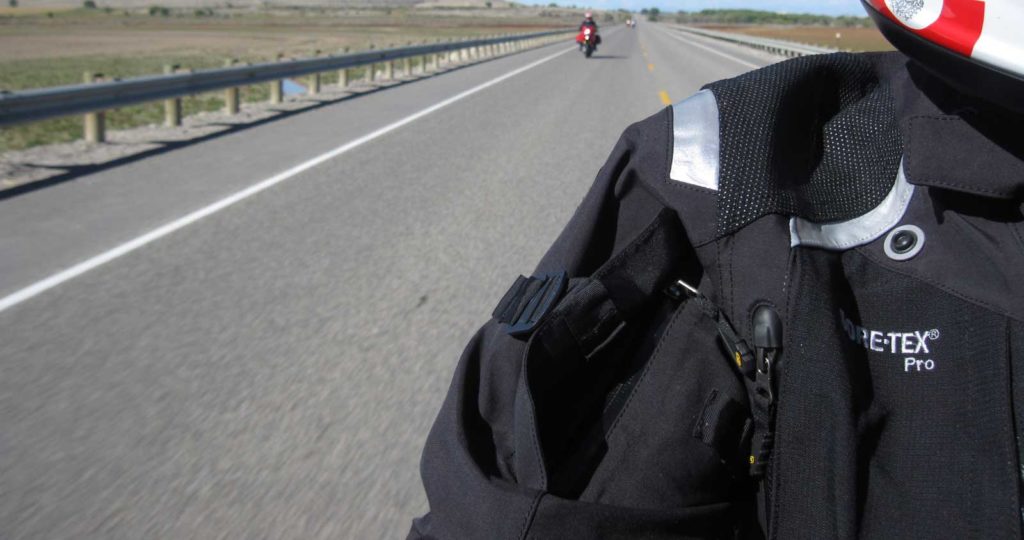
Traditionally, Velcro or snaps are used for arm straps and closures on most motorcycle coats, but Klim has employed Waveloc, military-spec, G-Hooks on the straps around the bicep vents, making it easier to adjust, open and close the vents on the arms. The G-Hooks are used to hold the vents open as well as adjust the room in the upper arm of the coat. If you have massive arms, puny arms (like myself) or are layering for hot or cold riding, these straps can be adjusted accordingly.
So Many Pockets
The jacket has so many pockets. Waist pockets, Napoleon pockets, pockets for your Spot GPS Messenger (or your keyless-fob on your Multistrada), hidden pockets for your passport. Some of the pockets even have extra features like the pockets for a media player, pockets for a water bladder, and a pocket that has a hook to keep your spare key safe. Pockets everywhere and everywhere you’d like a pocket.
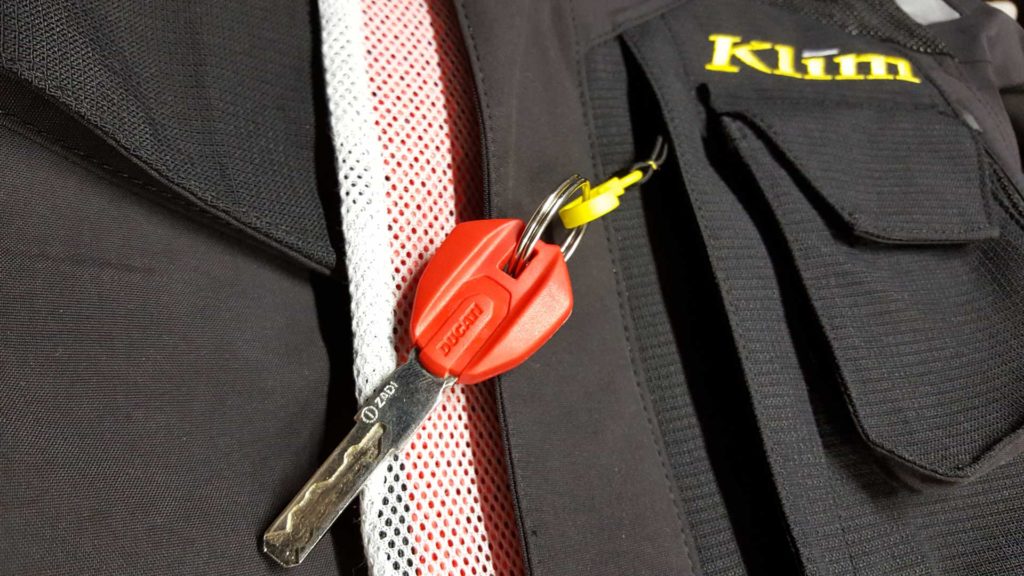
And then there is the Rabbit Pouch, the roomy pockets on the bottom of the back of the coat. They’ve become a feature found on many coats these days, but that does not diminish our love of the rabbit-pouch. Maps, hats, whatever, can be stashed and grabbed in a snap. Plus the location of the contents is such that filling up the pocket doesn’t have much of an effect on the fit and function of the coat. We love Rabbit Pouches so much that we would be reluctant to purchase a touring coat without one.
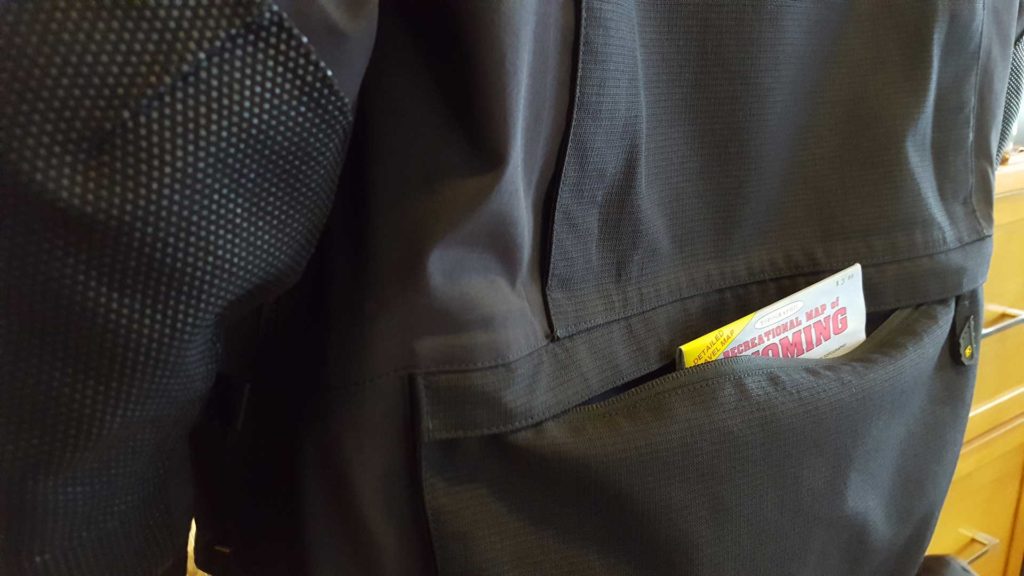
Neck
Additionally, the way the neck could be opened, fastened open or closed was pretty inspired. We always ride with a neck-gaiter/Buff, but a lot of air can enter a coat from the neckline. Clearly, Klim knows this because you can lock the neck-wide open, half-way open, partially open, or closed depending on the temperature and the air-flow needs. And to make the neck even more usable, they’ve employed a stretchy neck pull that allows you to snug the neck down even more so for dealing with ultra-cold or wet riding; very thoughtful.
Wrist Vents
When we first identified the subtle wrist vents we couldn’t imagine how they would be of much value. I mean, if your bike has hand-guards they are sheltered from any significant air flow. However, quite the opposite, actually. Even though they didn’t scoop in lots of air, they created a negative pressure “draw” as the wind passed over them, which resulted in maintaining the micro-climate, but more interestingly, the negative pressure kept the arm of the coat snugly in place!
What Was Less Than Perfect?
So, lets get down to brass tacks. What didn’t we like about the coat? Two things were less than perfect.
First, the wrists. Klim uses a very simple, single Velcro strap system around the wrist. It’s not overly bulky like many other Velcro-wrist systems, and yes, the Velcro does allow for a great deal of flexibility to adapt to different gloves, but this means you have to release and re-adjust the Velcro wrist every time the jacket comes on and off. We would love to see a hybrid system that employs a zipper along with the strap. A zipper would allow you to release and reset the wrist in a fraction of the time/hassle as just the Velcro straps alone.

When we asked Klim about this, we were told that one of the reasons this feature is missing is because of the Gore-Tex. We were told that Gore-Tex has to approve every aspect of the jacket because they (Gore-Tex) do not want anything to compromise the ability of the Gore-Tex to do it’s job. Understandable, but we still think this could be addressed and solved.
Second. We love – cannot tell you how much we love – the integrated kidney belt. But the right half of it had a tendency to fall into the jacket whenever we put the coat back on. Because we loved the Kidney belt so much, this became pretty frustrating. However, the first time we stripped the coat to be washed we noticed that one of the internal kidney belt straps was not wrapped around one of the retaining flaps on the liner of the coat. Once we reconnected the strap to the flap the kidney belt never fell back into the coat again. We mention this only in the event someone else has this problem.
Summary
Klim has 20 years of experience making gear for snowmobiles, which have to perform in a very brutal environment, so they know a thing or two about making a coat capable of dealing with the kind of weather. Plus, every jacket comes with a warranty that their gear will keep you dry for the lifetime of the garment. Plus, upping the game, they also have a Gear Protection Guarantee Program where if you crash and follow Klim’s process, they will replace any of their qualifying apparel free of charge!
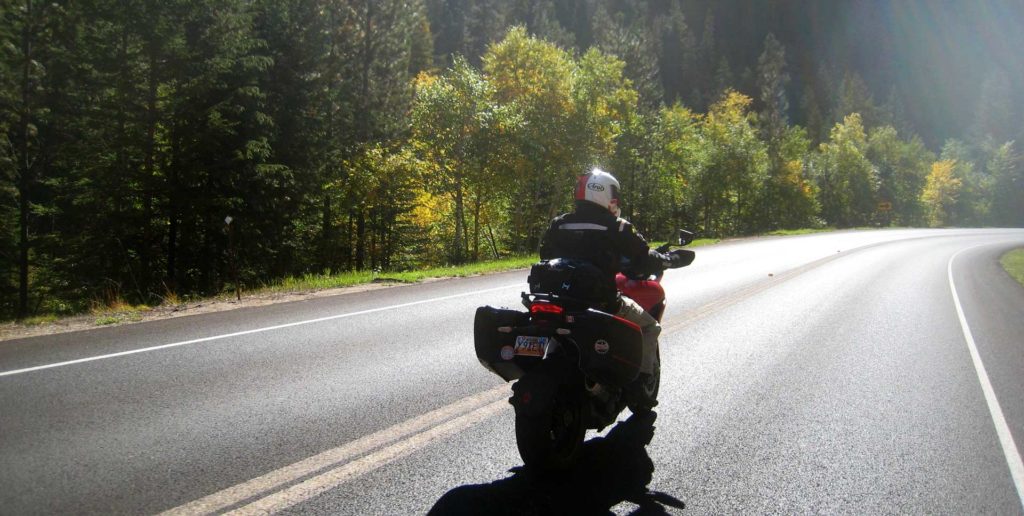
As Klim likes to say; “A cake is only as good as the ingredients.” They feature a Gore-Tex Pro membrane, YKK zippers, 3M reflectors, Rhino Thread, Superfabric, D3O Armor – all name brand components. Klim said, “Your whole product is only as good as your cheapest component.”
We completely agree. The Klim Badlands Coat, while expensive, proved to be worth every penny. The niggling little things, like the wrists and the kidney belt slipping into the coat, didn’t matter one bit when compared to how well the coat staved off the heat and cold and wet, keeping us warm, cool, happy and dry. Plus, it’s so comfortable that it becomes transparent, you forget you are wearing it. It’s one of the few pieces of equipment that, literally, enhanced the overall enjoyment of the motorcycle adventure experience.
One Last Thing
In what is probably one of the best way’s, to sum up how well the coat works, during this test, one of our most skeptical testers (Reviewing the Ladies Klim Altitude) would chime in;
“I don’t know why this coat is so expensive. It’s just a coat. And why is everyone complaining about how hot it is. It’s not Hot.”
“Kris, It’s 103-degrees.”
“Really?!?”
A few days later, she chimed in again over the headset.
“Why is everyone complaining about how cold it is!? It’s a little chilly, but not cold at all.”
“Kris, it’s 39-degrees.
“Really?!?!”
Klim has worked hard to develop a coat that is capable, not only of providing the protection we want to have to keep us safe in the event of a potential fall, but, more uniquely, they have also managed to isolate the rider from the swings in weather an adventure rider sees during the course of a trip. This has the added benefit of broadening the temperature and weather that we were willing to ride in as well as allowing us to be less distracted by being hot or cold or wet. As such, we give the Klim Badlands Coat the highest possible marks. It is, without a doubt, CanyonChaser Approved.
Learn more about Klim Badlands Coat.
